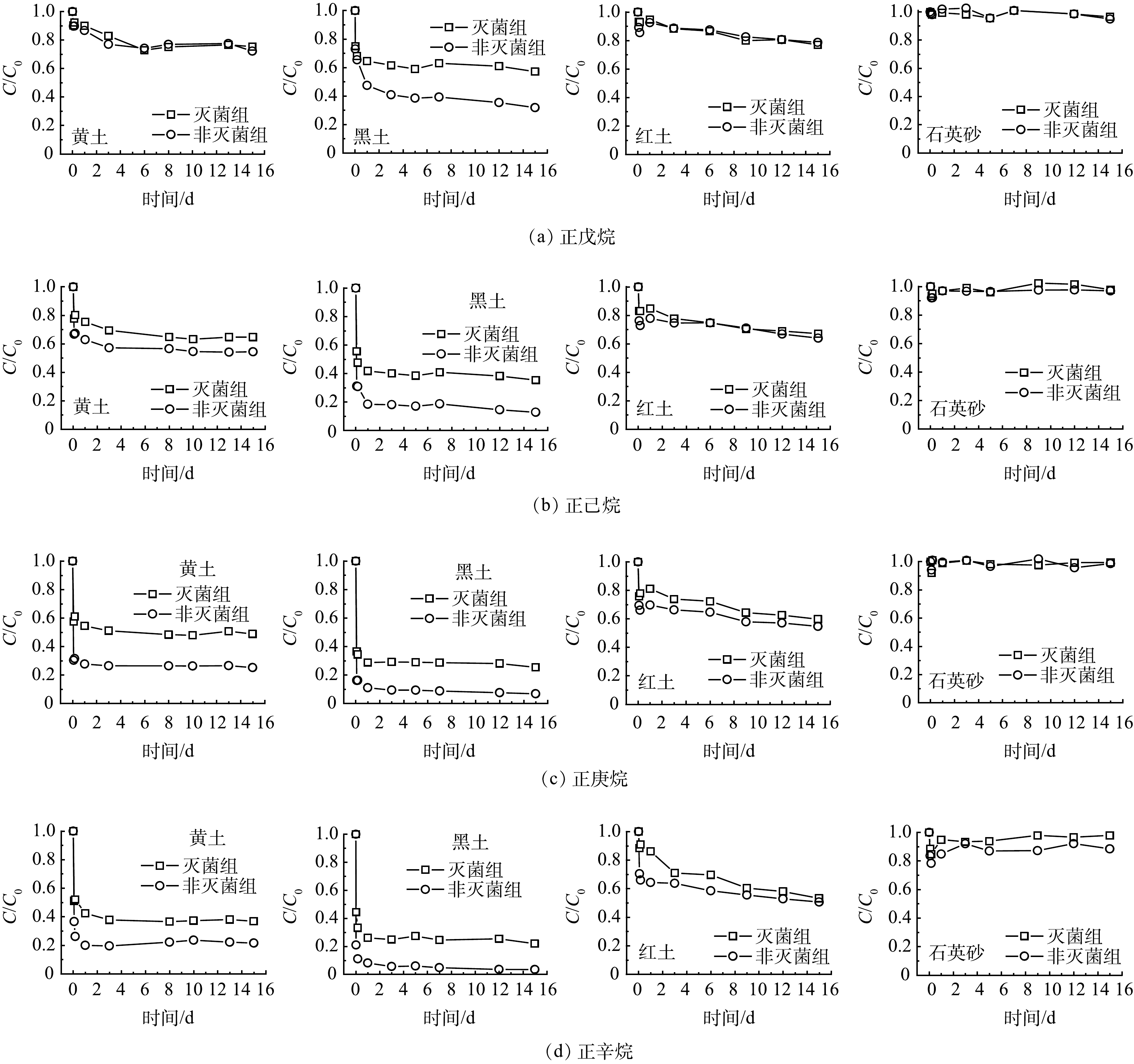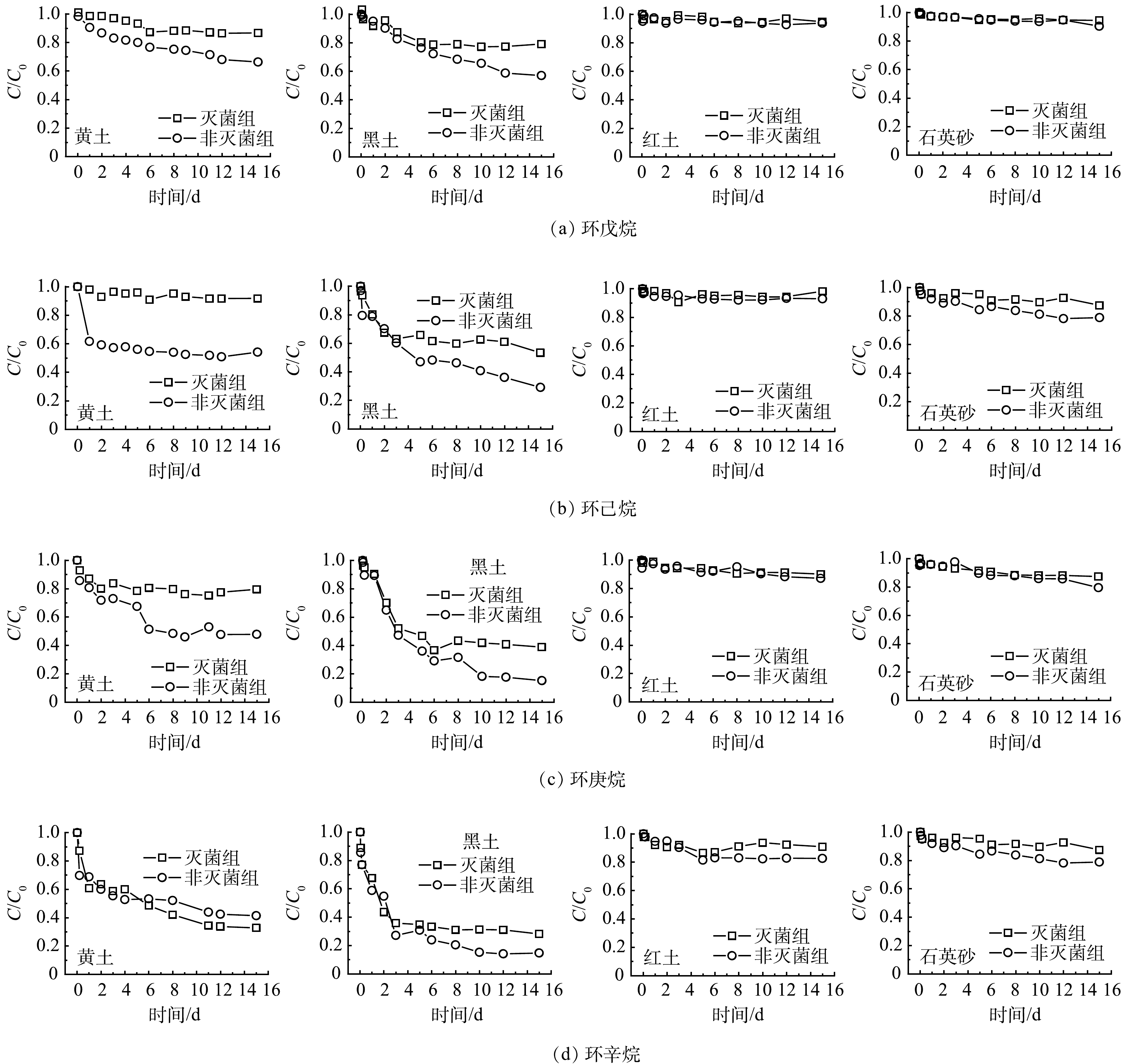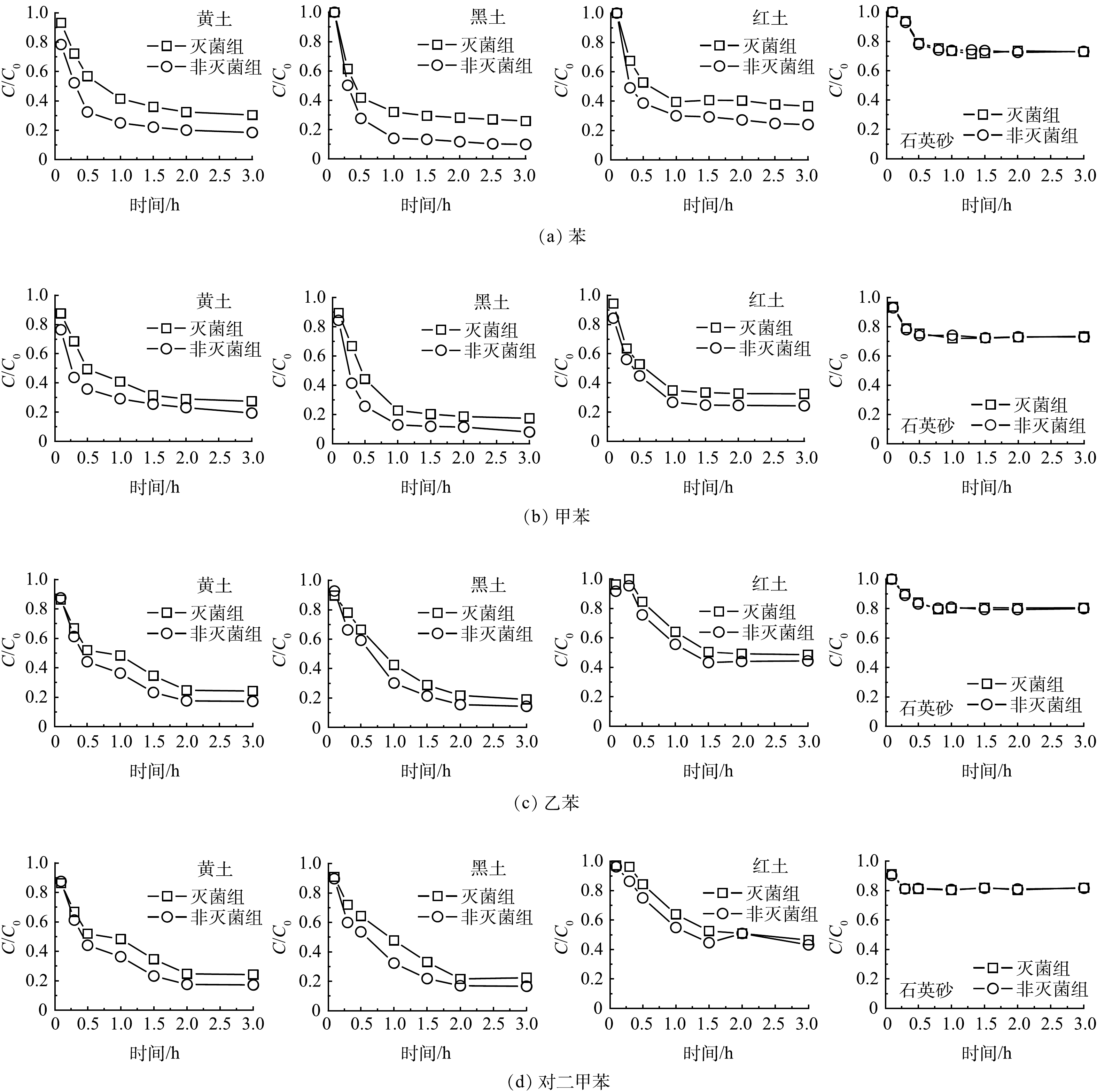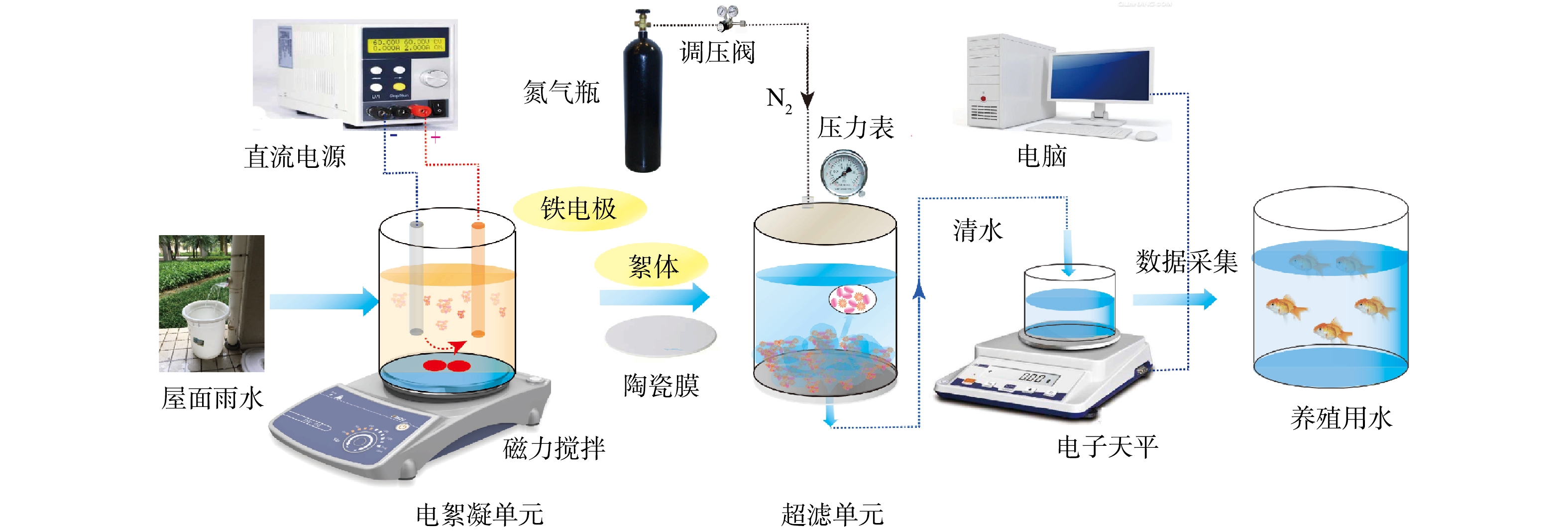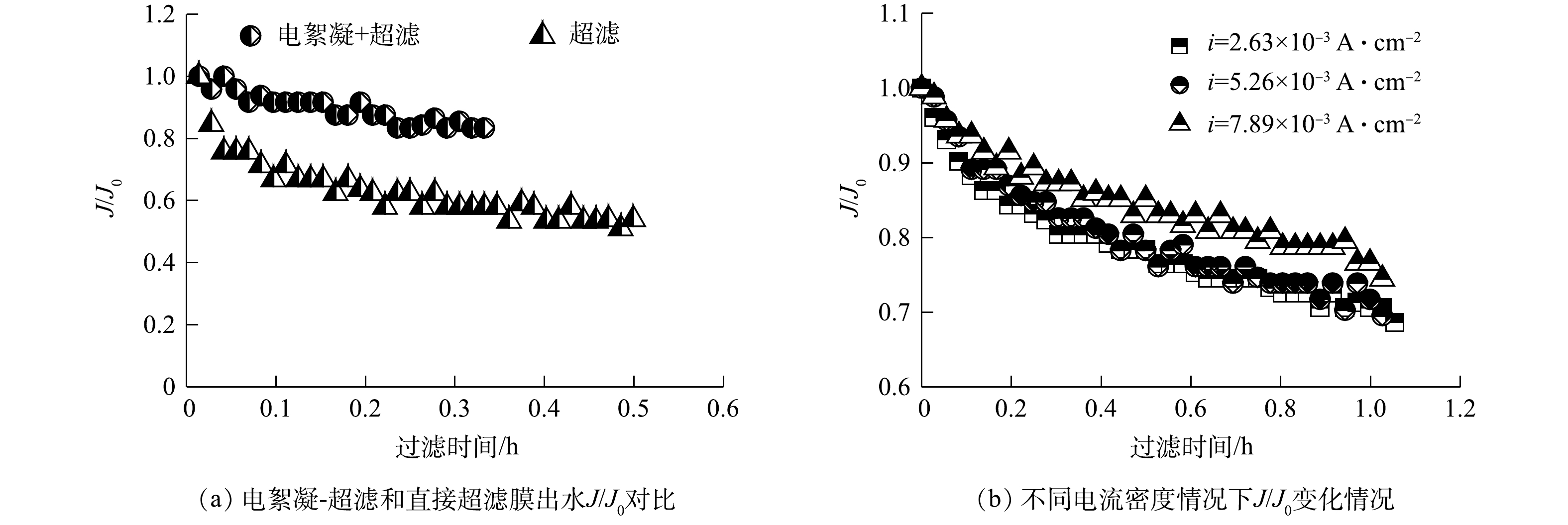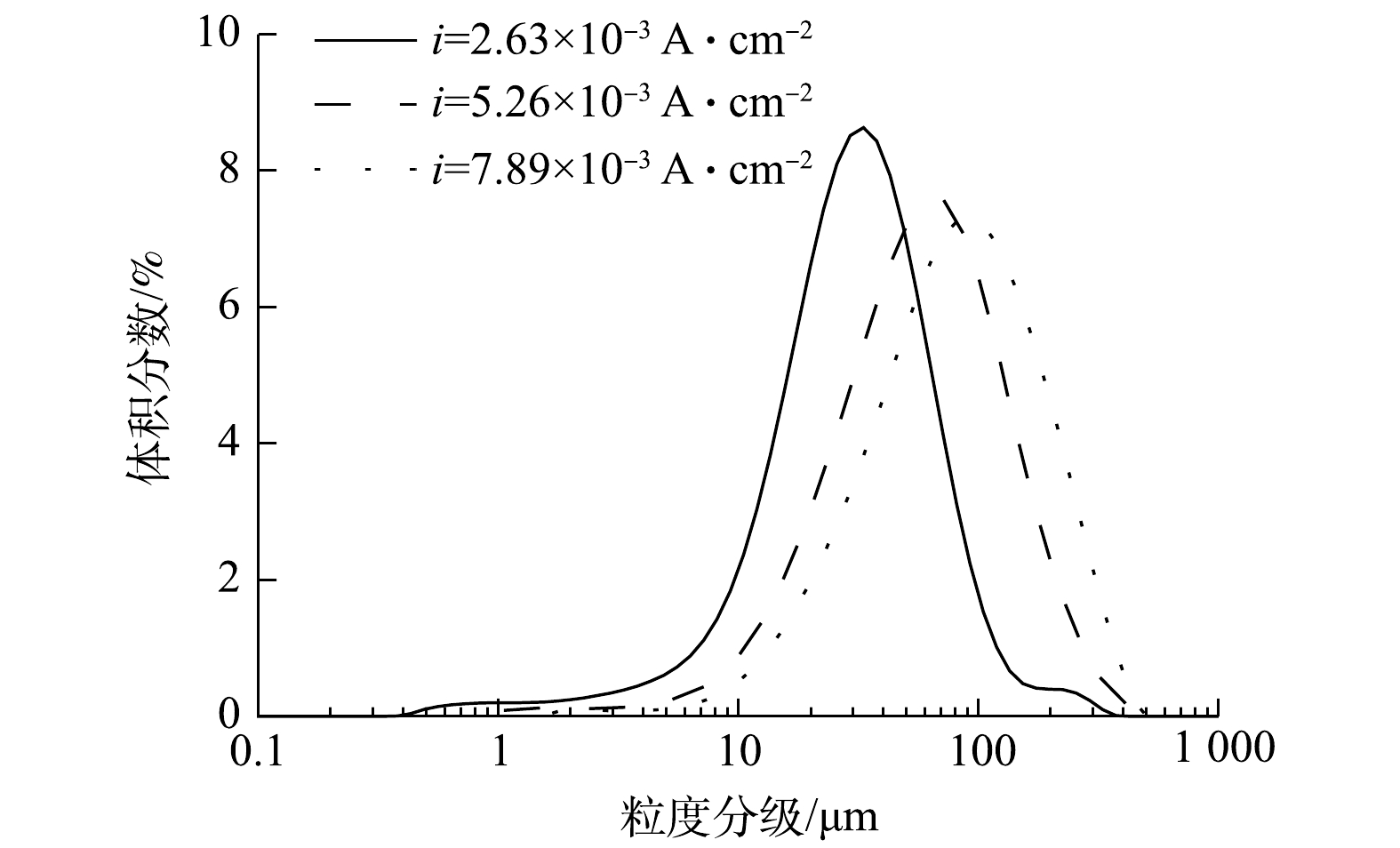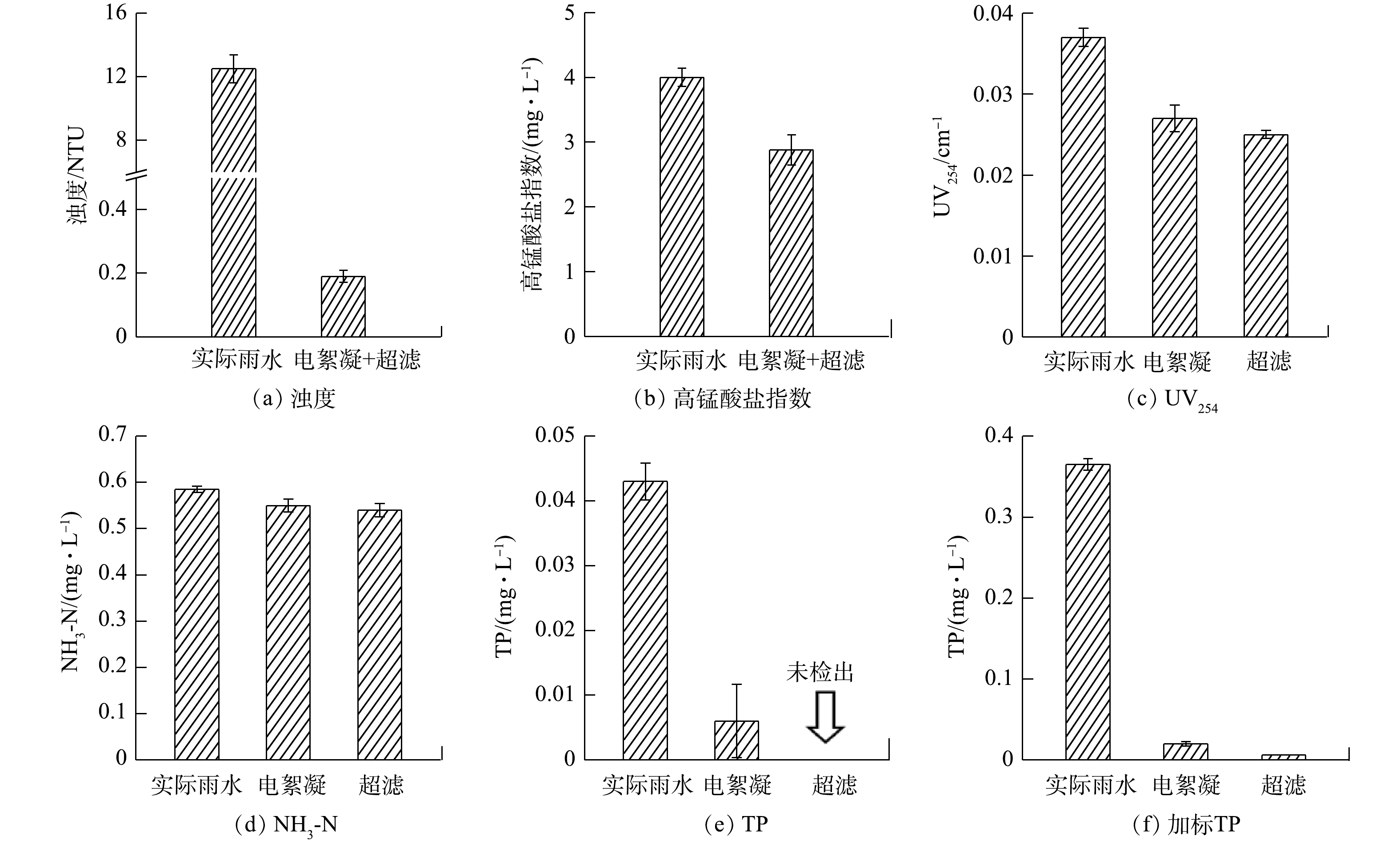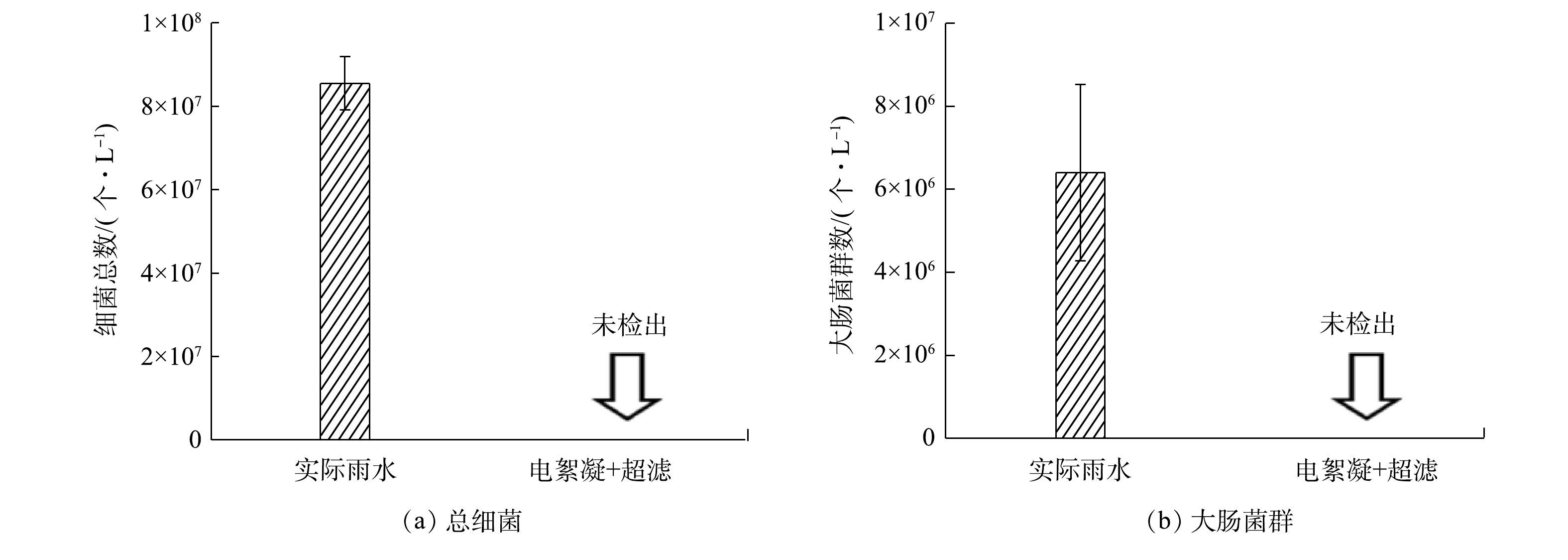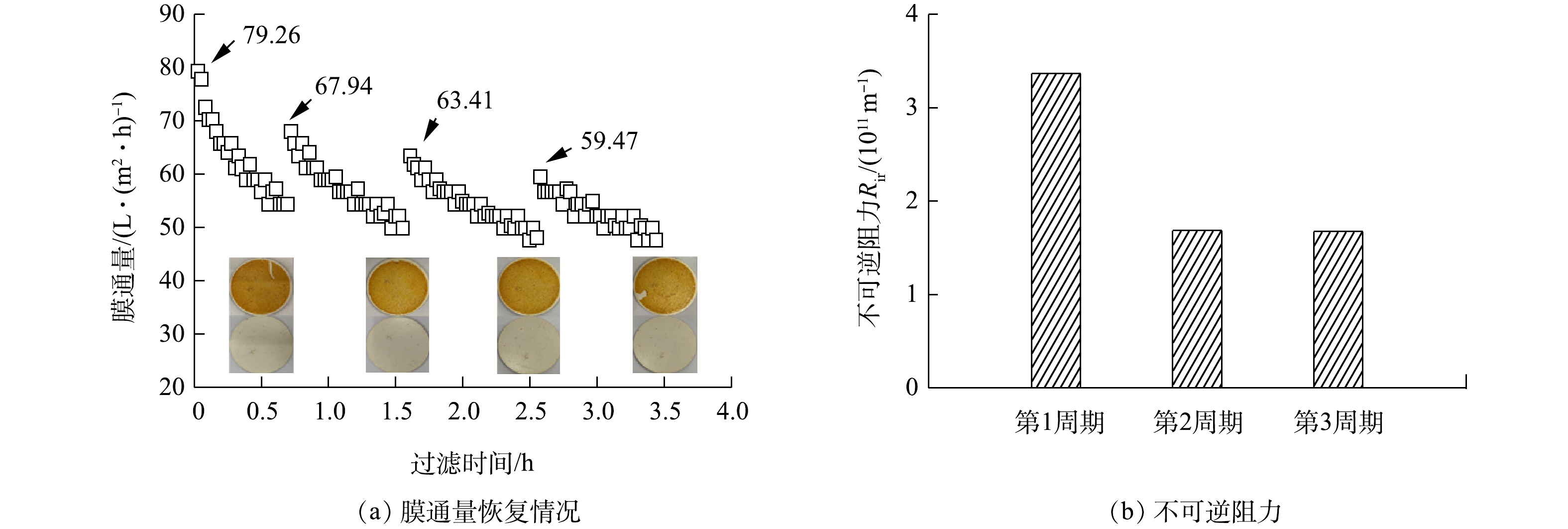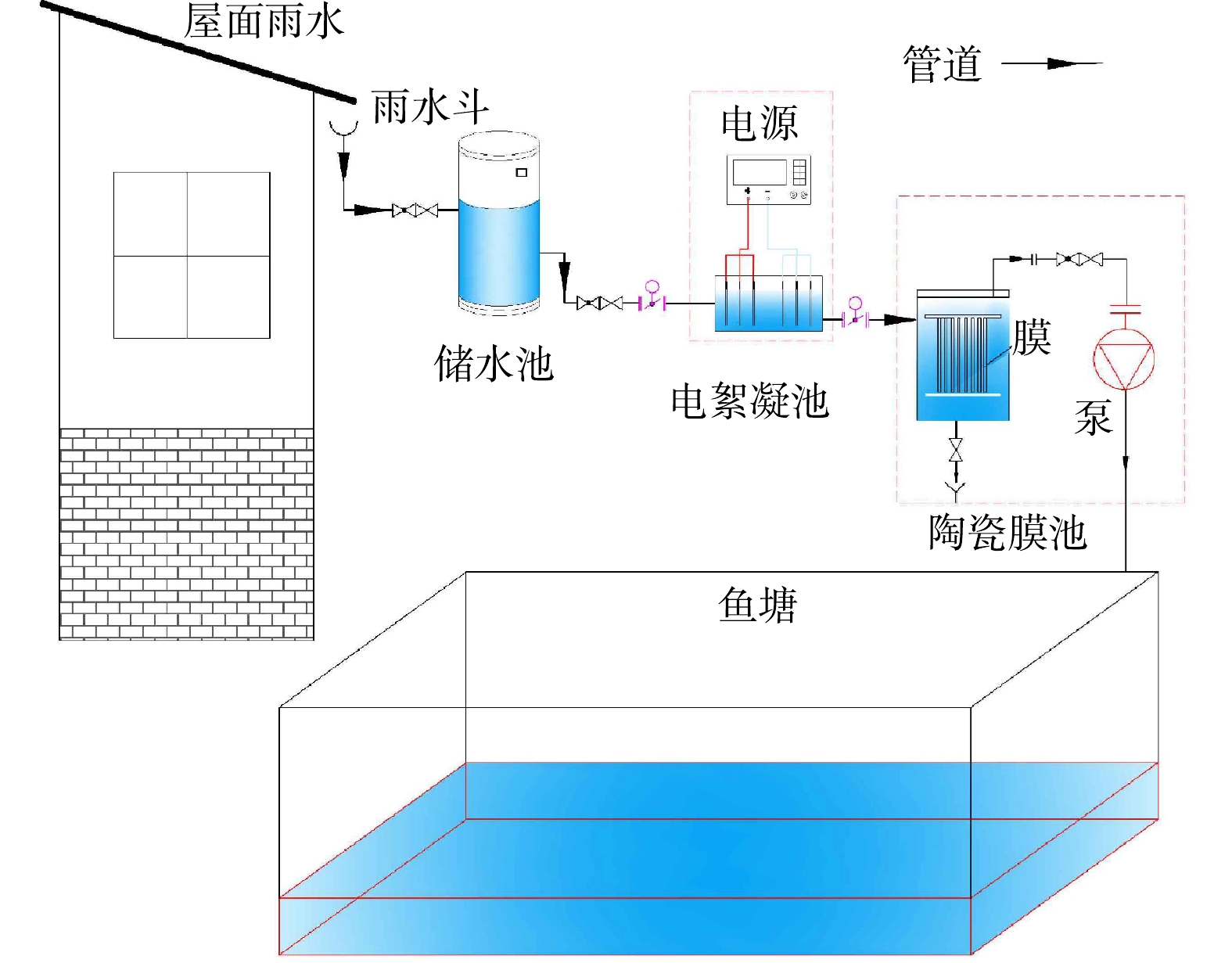-
水产品需求增加导致养殖用水增加,这与水资源短缺的矛盾日益凸显[1]。雨水再生与回用是解决此矛盾的有效途径之一。其中,屋面雨水由于水质较好、量大且易集蓄,具有一定的开发利用潜力[2]。更大的屋面区域可收集到更多的优质屋面雨水资源[3],比如工厂化水产养殖模式、“渔光互补”光伏发电新能源项目以及养殖区附近的大型建筑等均具有巨大的屋面区域,有助于屋面雨水汇集储存。雨水集蓄可以为养殖水循环系统(RAS)提供新的水源,并且能够在新的生产周期内满足水生动物的生长需求。GALLEGO-ALARCON等[4]采用生物滤池联合砂滤法对收集的雨水进行处理回用,提高了鳟鱼的长度/体质量比率及降低其死亡率。此外,其他学者[5]也利用蓄水池中的雨水进行鲤鱼养殖,进一步证实了雨水收集回用于渔业养殖用水的可行性。因此,将屋面雨水进行集蓄处理后回用于养殖用水,是缓解养殖用水危机的一种有效途径[6]。
目前,屋面雨水的污染主要源于干/湿沉降、屋面材料的冲刷溶解析出或化学反应、农业秸秆燃烧和汽车排放尾气等[6]。现阶段关于雨水处理的技术主要有混凝、沉淀等,但传统的雨水处理方法具有能耗高、不易操作和占地面积较大等缺点[6-7]。因此,如何开发一种集约高效的雨水处理工艺至关重要。有研究[1]表明,现有关于养殖用水前处理方法主要包括沉淀过滤、混凝/絮凝、杀菌消毒和生物降解等,但单一传统的养殖用水处理技术存在除污效能低、化学残留物对水生生物具有毒害作用及处理成本高等问题[8]。因此,为了提高屋面雨水利用效率和促进养殖业绿色生态发展,亟需开发一种新的处理屋面雨水回用于养殖尾水的短流程耦合工艺。
近年来,膜技术凭借占地面积小、运行管理方便和出水水质良好等优点获得了迅速发展。其中陶瓷膜具有机械强度高、耐酸碱、抗氧化和使用寿命长等优异性能,已逐渐应用于水处理领域[9]。然而,膜污染是阻碍膜技术推广的主要瓶颈[10]。膜前预处理(包括氧化、混凝、吸附等)可有效缓解膜污染[11]。近年来,以电絮凝预处理耦合陶瓷膜构建短流程工艺,能够实现高效净水功能,同时还可以节省占地面积。具体来说,在电絮凝处理污水过程中,牺牲阳极会释放大量具有絮凝特性的Fe2+、Fe3+或Al3+等,这些离子会与阴极产生的OH−接触,从而吸附凝聚水中污染物,之后形成的较大絮凝体可被陶瓷膜截留[12-13]。此外,电絮凝的应用还可以结合太阳能优势,将太阳能转化为电能,进而提升电絮凝应用的便捷性,降低成本。因此,将电絮凝技术和陶瓷膜滤法联用,对于提高屋面雨水的处理效能和保障养殖用水的卫生安全性具有重要意义。然而,现有关于电絮凝预处理耦合陶瓷膜工艺处理屋面雨水回用于养殖用水的研究较少。
基于此,本研究构建了电絮凝耦合陶瓷膜滤处理屋面雨水的一体化系统,其中电絮凝应用于屋面雨水的预处理,继而采用陶瓷膜进行高效的固液分离,将陶瓷膜出水作为养殖用水,以期为短流程工艺处理屋面雨水回用于养殖用水提供参考。
全文HTML
-
处理对象为实际屋面雨水和模拟屋面雨水,具体水质指标见表1。屋面雨水的水质特征主要取决于所处环境条件[14],其污染物来源于降水(湿沉降)、大气沉降(干沉降)和屋面材料溶解析出的物质[6]。尽管屋顶表面比停车场、人行道和不透水层相对更干净,但屋面雨水可能含有大量重金属和营养物质[15],且微生物种群会由于所处位置不同而呈现巨大差异[6]。
-
1)处理模拟雨水优化工艺参数实验。以模拟雨水为处理对象,改变电解时长(0~120 s)和电流密度(2.63×10−3~7.69×10−3 A·cm−2),测定不同工艺出水阶段(原水、电絮凝以及膜滤出水)的浊度、UV254和高锰酸盐指数,重金属离子含量,絮体粒径分布和膜出水通量变化情况。
2)处理实际雨水实验。在优化工艺条件下,以实际雨水为处理对象,测定不同工艺出水阶段(原水、电絮凝以及膜滤出水)的浊度、UV254、高锰酸盐指数和三维荧光光谱(EEMs),氨氮、总磷、重金属离子含量、细菌总数和大肠菌群数;同时,每个周期运行结束后采用水冲洗及海绵擦洗的方法去除陶瓷膜表面滤饼层,重复运行4个周期测定膜出水通量和不可逆阻力(Rir)的变化情况。
-
电絮凝反应器由2个电极和500 mL烧杯组成,其中电极均为纯铁铁棒(Ф=1.75 cm),其长度为10.5 cm,将2根铁棒插入溶液中,且间隔2 cm。首先快速搅拌1 min(G =495 s−1),电极的电解时长见1.2部分,然后进行15 min的慢速搅拌絮凝处理(G=32 s−1)。原水经电絮凝处理后进入陶瓷膜超滤单元进行固液分离。圆片平板陶瓷膜(TAMI Industries, France)的有效过滤面积为1.38×10−3 m2,且膜片的相对截留分子质量为50 kDa,其支持层和过滤层的材料分别为TiO2和ZrO2/TiO2混合物。超滤采用死端膜过滤方式,主要过滤单元为120 mL超滤杯,过滤系统压力控制为40 kPa。通过电子天平和电脑连接可以获得自动化记录数据,从而测量滤液流量变化情况,进而根据膜面积计算通量。整个实验过程在25 ℃恒温下进行。耦合工艺实验装置如图1所示。
-
采用电感耦合等离子体质谱仪(7700, Agilent, USA)对水样中重金属含量进行检测;使用浊度计(2100P, Hach, USA)测定浊度;pH的测定采用pH计(ST3100, Ohaus, China);利用酸性高锰酸钾滴定法测定高锰酸盐指数,NH3-N采用钠氏试剂分光光度法测定,TP采用钼锑抗分光光度法测定,其中NH3-N和UV254通过紫外分光光度计来检测;使用激光衍射粒度仪(LSPA, Malvern Instruments Ltd., UK)在25 ℃下测量絮体粒径分布;通过荧光光谱仪(FS5, Edinburgh, UK)获取雨水的荧光光谱,石英比色皿尺寸为1 cm,激发波长为220~450 nm,间隔为5 nm,发射波长为250~550 nm,间隔为5 nm,以超纯水作为空白对照以扣除样品大部分的拉曼散射峰,每个样品经0.45 µm滤膜过滤后进行测量;利用涂布平板法计算测定细菌总数;采用选择性琼脂(CM1046)在37 ℃下对大肠菌群进行培养,培养时长为24 h,其中紫色菌落代表大肠菌群,而红色/粉色菌落被认为是其他菌群。
1.1. 原水水质
1.2. 实验设计
1.3. 实验装置
1.4. 分析方法
-
1)电解时长对模拟雨水的UV254去除效能的影响。UV254可用于表征有机物的芳香特性[16]。在不同电解时长条件下,电絮凝对模拟雨水UV254的去除效能见图2。如图2所示,当电流密度(i)为2.63×10−3 A·cm−2时,随着电解时长的延长,雨水UV254逐渐降低,但电解10 s后趋向稳定;当增大电流密度时,电絮凝对UV254的去除效能呈现相似的趋势,且会随着电流密度的增大而增强,但增强幅度不大。电解时长与整个电絮凝过程中Fe2+的产生量有关[12],综合考虑电絮凝对雨水中有机物的去除效能和后续可能对陶瓷膜过滤中膜污染的缓解作用[13],在后续实验中选取电絮凝处理工艺的最佳电解时长为60 s。
2)耦合工艺对模拟雨水常规指标的去除效能。屋面雨水中颗粒物主要来源于农业秸秆燃烧和汽车排放尾气等,而溶解性有机物(DOM)来源于雨水中化学物质和屋面材料的化学反应等[12],这类成分对后续养殖用水水质存在一定的影响[6]。图3为耦合工艺对模拟雨水的浊度、高锰酸盐指数及UV254的去除情况。如图3(a)所示,模拟雨水经过耦合工艺处理后,其浊度由12.5~15.2 NTU降低到0.12~0.18 NTU,去除率达到98.75%~99.08%。因此,电絮凝耦合陶瓷膜工艺对于模拟雨水中颗粒物具有显著的处理效果。同时,如图3(b)所示,当电流密度增大时,耦合工艺对模拟雨水高锰酸盐指数的去除率逐渐增加(12.73%~53.03%),尤其当电流密度为7.89×10−3 A·cm−2时,耦合工艺出水高锰酸盐指数由3.30 mg·L−1降低到1.55 mg·L−1。此外,由图3(c)可以看出,耦合工艺可以较好地除去模拟雨水中的芳香性有机物,UV254由0.040~0.041 cm−1降低到0.024~0.025 cm−1,去除率达到37.5%~41.5%。可见,在较宽的电流密度范围(2.63×10−3~7.89×10−3 A·cm−2)内,耦合工艺对有机物有一定的去除效能。前期研究[12]表明,电絮凝过程可以通过混凝作用去除部分有机物,且形成的絮体对陶瓷膜过滤通量产生严重影响。
3)电流密度对絮体粒径和陶瓷膜滤特性的影响。由图4(a)可见,在原水直接超滤过程中,出水的标准化通量(J/J0)降低至0.58,而电絮凝预处理后陶瓷膜出水的J/J0明显提升至0.89。正如我们所预测,如图4(b)所示,在较大电流密度(7.89×10−3 A·cm−2)的情况下,滤液的J/J0由1.0降低至0.75,高于较小电流密度(2.63×10−3 A·cm−2和5.26×10−3 A·cm−2)运行结束时的情况(J/J0=0.69,0.71)。根据DASHTBAN等[17]的研究结果,溶液中的颗粒物会对陶瓷膜的滤饼层产生影响,进而影响陶瓷膜滤特性。此外,由图5可以看出,随着电流密度的增加,絮体粒径呈现增大的趋势(39~103 µm),且絮体最大粒径分别为425.89、483.88和549.77 µm。有研究[17]表明,电絮凝过程产生的较大粒径的絮体会增强陶瓷膜过滤特性。当电流密度较小时,电絮凝对于污染物的脱稳、凝聚作用较弱,从而导致生成的絮体粒径较小,不利于形成疏松的滤饼层,同时污染物容易堵塞膜孔[18]。可见,耦合工艺中电絮凝预处理雨水在一定程度上可以缓解膜污染,同时提升膜通量,但随着电流密度的减小,膜污染程度加重。
-
1)耦合工艺对实际雨水常规指标的去除效能。基于耦合工艺处理模拟雨水的研究结果,发现即使电流密度为2.63×10−3 A·cm−2和5.26×10−3 A·cm−2时,耦合工艺的除污效能相差不显著,但当电流密度为5.26×10−3 A·cm−2时,模拟雨水的高锰酸盐指数,UV254和絮体粒径都比低电流密度(2.63×10−3 A·cm−2)的更高。此外,GONZALEZ-OLMOS等[19]的研究表明,较高的电流密度有助于提高污染物的去除性能和降低膜污染。因此,综合考虑耦合工艺的处理效能和节省能耗,当以实际雨水为处理对象时,固定电流密度为5.26×10−3 A·cm−2,考察耦合工艺处理实际雨水的适用性。
耦合工艺对实际雨水的浊度、UV254、高锰酸盐指数、氨氮、总磷和加标总磷的去除情况见图6。如图6(a)~(c)所示,实际雨水经处理后,其浊度由12.5 NTU降低到0.19 NTU,高锰酸盐指数和UV254分别由4.00 mg·L−1和0.037 cm−1降低到2.88 mg·L−1和0.025 cm−1。可见,耦合工艺对实际雨水以上3项常规指标的去除效能良好。此外,由图6(e)可以看出,实际雨水中的总磷含量由0.043 mg·L−1降低至0 mg·L−1。为进一步验证耦合工艺的除磷性能,向实际雨水中添加总磷标准溶液以提高雨水中总磷的含量。由图6(f)可知,加标总磷含量由0.37 mg·L−1降低至0.01 mg·L−1,总磷的去除率为98.38%。因此,高总磷去除率充分反映了耦合工艺对总磷具有显著的去除效果。电絮凝过程释放的Fe2+、Fe3+会与溶液中OH−结合生成Fe(OH)2和Fe(OH)3沉淀,继而通过吸附混凝作用除去雨水中的溶解态含磷物质[12]。即使耦合工艺对氨氮没有明显的去除作用(图6(d)),但较低的含氮量不会影响养殖用水水质要求。
2)耦合工艺中实际雨水三维荧光光谱(EEMs)的变化。DOM是雨水处理中重要的去除对象,而三维荧光光谱能够直观反映DOM化学特性的变化情况[20]。实际雨水以及各处理单元出水的三维荧光光谱见图7。由图7可见,实际雨水中主要含有类色氨酸荧光峰(Ex/Em=220~235 nm/340~360 nm),即雨水的有机物构成主要是类色氨酸[21]。此外,由图7(a)~(c)可以看出,随着耦合工艺处理流程的进行,雨水的EEMs特征发生变化,其中类色氨酸组分荧光强度逐渐降低,峰值由7 260降低至6 010。这说明耦合工艺能够在一定程度上除去实际雨水中的类蛋白质有机物,从而为实际雨水回用于养殖用水提供保障。
3)电流密度对耦合工艺处理实际雨水微生物指标的影响。将屋面雨水收集处理回用于养殖用水时,微生物指标是必须考虑的。因为《无公害食品:淡水养殖用水水质》(NY 5051-2001)对大肠菌群有严格的要求。如图8所示,实际雨水中细菌总数和大肠菌群数分别为8.55×107个·L−1和6.4×106个·L−1,大肠菌群数已超过《无公害食品:淡水养殖用水水质》(NY 5051-2001)的标准值。实际雨水经过耦合工艺处理后,出水中大肠菌群和其他细菌均未检出,极大地提高了养殖用水的生物安全性。需要指出的是,收集和储存雨水中的微生物种群会由于来源不同而呈现实质性差异,这主要取决于气候条件(风速、风向和降雨特征)、初期雨水以及可能接触到收集表面的野生动物种类(鸟、猫或狐狸)等。众所周知,鸟类是致病菌的主要来源,而其他来源包括干沉降(足够大的颗粒可以携带微生物)以及湿沉降。大部分研究[6]表明,由于屋顶表面沉积的动物粪便逐渐增加,长时间的干旱天气将导致屋面雨水中微生物丰度逐渐升高。GHERNAOUT等[22]指出,电絮凝产生的铁盐可以形成絮体,与细菌共沉淀后能够被膜滤除去,这与本研究结果一致。
4)不同运行周期膜通量恢复实验。不同运行周期陶瓷膜通量变化情况如图9(a)所示。在第1个运行周期内,运行1 h后膜通量由79.26 L·(m2·h)−1降低到53.87 L·(m2·h)−1,污染后的膜经物理清洗后其通量恢复至67.94 L·(m2·h)−1,有较明显的恢复效果。在第2个运行周期内,膜通量由67.94 L·(m2·h)−1降低到48 L·(m2·h)−1,且膜通量衰减速率有所减缓。此外,第3、4个运行周期中的膜通量变化情况呈现类似趋势。由图9(a)可以直观地看到,物理清洗能够有效除去陶瓷膜表面滤饼层,既有利于恢复膜通量,也在一定程度上缓解了膜污染。这可能与陶瓷膜对有机物的截留有关(图7),即实际雨水经陶瓷膜过滤后,其类色氨酸组分的峰值下降。此外,在第1、2和3个运行周期中,不可逆阻力分别为3.37×1011、1.68×1011和1.67×1011 m−1(图9(b)),即在长期运行过程中,电絮凝预处理工艺可导致不可逆阻力逐渐下降。类似现象在此种工艺用于地表水的研究[12-13]中也有报道。
-
屋面雨水中的重金属来源于初级沉降对屋顶表面积累的颗粒物和析出材料的冲刷[6],这些重金属对于屋面雨水回用于养殖水水质具有一定影响,因此,除去屋面雨水中的重金属非常重要。耦合工艺对Zn和Cu的去除效能如图10所示。
如图10(a)~(b)所示,在较大电流密度(7.89×10−3 A·cm2)条件下,Zn和Cu的含量分别由116.53 µg·L−1和270.61 µg·L−1降低至5.30 µg·L−1和3.46 µg·L−1,去除率分别为95.5%和98.7%。由此可见,耦合工艺对重金属的去除效能极其显著,且耦合工艺对重金属的去除效能随着电流密度的增大而增强。根据电絮凝的机理可知,通过电流触发阳极铁棒溶解能够原位生成铁盐混凝剂,同时在阴极附近形成羟基离子。在铁盐混凝剂的作用下,重金属会发生絮凝沉淀作用[23],进而可以被陶瓷膜截留去除。此外,大量的氢氧化物会与锌和铜等共沉淀,形成铁氧化物[24]。
基于上述研究结果,选取电流密度为5.26×10−3 A·cm−2对实际雨水进行处理,以考察超滤过程不同运行周期对重金属去除效能的影响。由图10(c)~(d)可以看出,随着超滤过程运行周期的延长,出水中Zn和Cu含量逐渐降低,其含量分别由45.27 µg·L−1和12.21 µg·L−1降低至4.61 µg·L−1和4.31 µg·L−1。需要指出的是,雨水中锌和铜主要来源于炼油排放、石化生产以及森林产品生产等[6]。可见,耦合工艺能够有效去除屋面雨水中可能存在的重金属,从而使出水水质符合《无公害食品:淡水养殖用水水质》(NY 5051-2001)的标准,进而提高养殖用水的安全性。
-
本短程工艺利用电絮凝过程产生的铁盐与屋面雨水中颗粒物、有机物和微生物发生混凝作用,同时与总磷,重金属(锌和铜)发生共沉淀作用,进而形成较大絮体,从而被陶瓷膜截留去除,使工艺出水达到养殖用水的要求。该耦合工艺的应用构想如图11所示。具体过程为:采用储水池将屋面雨水收集,之后以储水池与絮凝池之间的液面差作为驱动力,利用重力流入电絮凝池进行混凝处理,继而混凝出水靠重力流入陶瓷膜池,最后利用陶瓷膜的高通量特性使处理后出水经抽吸泵或重力过滤直接进入养殖池中。由于雨水收集池、电絮凝池及陶瓷膜池等的规模和构型均可根据建筑和养殖池的实际尺寸进行设计,即以该耦合工艺为基础设计的屋面雨水回用设备的设置和安装具有很高灵活性,为该耦合工艺的推广应用提供了可行性。
综上所述,电絮凝预处理能够强化陶瓷膜滤,从而净化出水水质和延缓膜污染,而联合陶瓷膜滤可以高效分离絮体。构建屋面雨水回用于养殖用水的高效水处理系统,既可缓解养殖用水紧缺的危机,也能提高城市屋面雨水的利用效率,进而响应了中国政府关于海绵城市的政策倡议[6]。此外,电絮凝技术对海水养殖尾水中主要污染物(藻类、抗生素、磷酸盐等)均具有显著的去除能力,且不受高盐度的影响[25],能够替代传统的微生物处理法而稳定高效地处理海水养殖尾水,因此,电絮凝耦合陶瓷膜滤技术在海水养殖中的应用前景可期。
2.1. 耦合工艺对模拟雨水去除效能的研究
2.2. 耦合工艺对实际雨水去除效能
2.3. 耦合工艺对重金属的去除效能
2.4. 机理和应用
-
1)电絮凝耦合陶瓷膜滤短流程工艺在通电时长60 s条件下,对于屋面雨水的浊度、高锰酸盐指数、UV254、总磷和细菌总数均有明显去除效能,甚至能保证出水中大肠菌群未检出,完全符合《无公害食品:淡水养殖用水水质》(NY 5051-2001)水质要求。
2)耦合工艺在处理屋面雨水的重金属方面具有突出效能,出水中锌和铜的含量均较低(Zn<4.61 µg·L−1, Cu<4.31 µg·L−1),已满足养殖用水水质要求。
3)随着电流密度增大(2.63×10−3~7.89×10−3 A·cm−2),电絮凝出水絮体粒径逐渐增加(39~103 µm),且陶瓷膜污染程度逐渐减缓。此外,在多周期运行过程中,电絮凝预处理工艺可以降低不可逆性膜污染的程度。





 DownLoad:
DownLoad:
